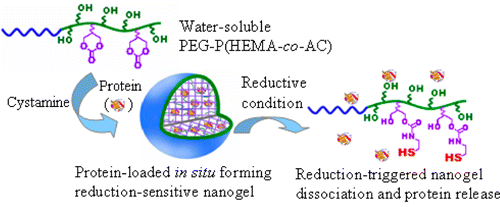In Situ Forming Reduction-Sensitive Degradable Nanogels for Facile Loading and Triggered Intracellular Release of Proteins
Wei Chen †‡, Meng Zheng †, Fenghua Meng †, Ru Cheng †, Chao Deng †, Jan Feijen †‡, and Zhiyuan Zhong *† (钟志远)
† Biomedical Polymers Laboratory and Jiangsu Key Laboratory of Advanced Functional Polymer Design and Application, Department of Polymer Science and Engineering, College of Chemistry, Chemical Engineering and Materials Science, Soochow University, Suzhou, 215123, P. R. China
‡ Department of Polymer Chemistry and Biomaterials, Faculty of Science and Technology, MIRA Institute for Biomedical Technology and Technical Medicine, University of Twente, P.O. Box 217, 7500 AE Enschede, The Netherlands
Biomacromolecules, 2013, 14, 1214–1222.
In situ forming reduction-sensitive degradable nanogels were designed and developed based on poly(ethylene glycol)-b-poly(2-(hydroxyethyl) methacrylate-co-acryloyl carbonate) (PEG-P(HEMA-co-AC)) block copolymers for efficient loading as well as triggered intracellular release of proteins. PEG-P(HEMA-co-AC) copolymers were prepared with controlled Mn of 9.1, 9.5, and 9.9 kg/mol and varying numbers of AC units per molecule of 7, 9 and 11, respectively (denoted as copolymer 1, 2, and 3) by reversible addition–fragmentation chain transfer copolymerization. These copolymers were freely soluble in phosphate buffer but formed disulfide-cross-linked nanogels with defined sizes ranging from 72.5 to 124.1 nm in the presence of cystamine via ring-opening reaction with cyclic carbonate groups. The sizes of nanogels decreased with increasing AC units as a result of increased cross-linking density. Dynamic light scattering studies showed that these nanogels though stable at physiological conditions were rapidly dissociated in response to 10 mM dithiothreitol (DTT). Interestingly, FITC-labeled cytochrome C (FITC–CC) could be readily loaded into nanogels with remarkable loading efficiencies (up to 98.2%) and loading contents (up to 48.2 wt.%). The in vitro release studies showed that release of FITC–CC was minimal under physiological conditions but significantly enhanced under reductive conditions in the presence of 10 mM DTT with about 96.8% of FITC–CC released in 22 h from nanogel 1. In contrast, protein release from 1,4-butanediamine cross-linked nanogels (reduction-insensitive control) remained low under otherwise the same conditions. MTT assays showed that these nanogels were nontoxic to HeLa cells up to a tested concentration of 2 mg/mL. Confocal microscopy results showed that nanogel 1 delivered and released FITC–CC into the perinuclei region of HeLa cells following 8 h incubation. CC-loaded reductively degradable nanogels demonstrated apparently better apoptotic activity than free CC as well as reduction-insensitive controls. These in situ forming, surfactant and oil-free, and reduction-sensitive degradable nanogels are highly promising for targeted protein therapy.

链接: //pubs.acs.org/doi/pdf/10.1021/bm400206m